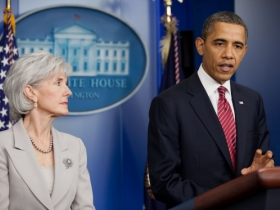Court Decision Could Kill Obamacare in Wisconsin
That would hurt many who’ve enrolled, and leave Gov. Walker in a tough position.
With the headline, In Blow to Health Law, Appeals Court Limits Subsidies, the New York Times announced the decision in Halbig v. Burwell. Voting 2-1 along partisan lines a three judge panel of the DC Court of Appeals ruled that subsidies for the purchase of healthcare could only be available in states that set up their own exchanges, not those, including Wisconsin, that depend on federal exchanges. Within two hours another appeals court ruled in favor of the subsidies. Both decisions are sure to be appealed, but the impact on Wisconsin and other states could be drastic depending on which way the courts decide.
According to federal figures, by April 1 when open enrollment ended 139,815 Wisconsinites signed up for insurance through the Marketplace, 91 percent of whom received federal financial assistance. While enrollment continues to grow, updated figures for Wisconsin haven’t been published.
People who qualified for the subsidies may now be very worried about losing them. Without the subsidy, most of those removed from Medicaid could not afford the premiums, leaving them with no insurance. They may have concerns that if the courts rule against the subsidies, the decision could be retroactive, leading to thousands of dollars of debt. The resulting fear and uncertainty could cause some to either drop their insurance or not sign up in this fall’s open enrollment period, depressing enrollment while courts consider what to do.
In the long run, what would happen if the Halbig decision is ultimately upheld? This would likely destroy the individual health insurance market in states depending on the federal exchange, including Wisconsin. Here’s how that would work: the Affordable Care Act is sometimes described as a three-legged stool. The first leg is the individual mandate that requires people to buy insurance, so long as it is affordable. The second leg is the subsidy designed to keep the cost affordable. The third is a rule that prohibits insurance companies from denying coverage or charging different prices based on an applicant’s health or pre-existing conditions.
That, in itself, would cause premiums to rise. Hospital emergency rooms, which under federal law are required to treat a patient whether or not that person can pay the bill, would see more bad debt. This would be passed on to those who can pay, including individual and employer insurance plans.
It wouldn’t stop there. People at the low end of the income range qualifying for subsidies would have no choice but to go without insurance if the subsidy went away, but those at the upper range would face a decision: sacrifice other purchases to buy insurance or go without and hope for the best. Here is where the dreaded specter of adverse selection kicks in. Those most likely to make the sacrifice to pay the unsubsidized premium are those expecting large health bills, such as people with on-going medical problems or families planning to have children.
The third leg of the ACA prohibits insurance companies from taking the health of the applicant into consideration. They cannot deny treatment for pre-existing conditions. In setting rates they must use “community rating” where everyone pays the same price—rather than “experience rating” geared to the individual. Since people choosing to buy insurance despite high prices will be those expecting to use it, premiums will rise further, causing more people to drop their insurance. This could easily lead to a spiral of growing premiums and declining enrollment, resulting to the death of the individual insurance market in Wisconsin. Even young, healthy people would not be able to buy an individual policy.
I find the politics of this situation inexplicable. Conservative groups like the Cato Foundation, conservative media like the Wall Street Journal editorial page, and conservative politicians like Wisconsin’s own Ron Johnson, are all applauding the Halbig decision. Some are even arguing that the wording in the Affordable Care Act was deliberate, that it was put into the law as an incentive to encourage states to set up their own exchanges. But when Governor Walker was deciding to go with the federal exchange, no one warned him he was putting the federal subsidy at risk. A secret incentive is not much of an incentive.
Recently there has been a spate of good news about the Affordable Care Act:
- The Kaiser Family Foundation reported that 58 percent of people in California who did not have insurance last year have insurance this year. If only those eligible for insurance are counted the proportion rises to 66 percent.
- Bloomberg reports that HCA, a large hospital chain, “reported a 6.6 percent drop in uninsured patients at its 165 hospitals, a reduction that grows to 48 percent in four states that expanded Medicaid.”
- The 2014 Medicare Trustees report noted that an “improvement in the outlook for HI [hospital insurance] long-term finances is principally due to lower-than-expected spending in 2013 for most HI service categories.”
Since the predicted Obamacare train wreck has failed to materialize, the law’s opponents have seized on ambiguous wording in the Affordable Care Act to try to create a train wreck on their own. What they don’t seem to have considered is that the train wreck, if it comes, will be very selective. It will hit states like Wisconsin that opted to use the federal Marketplace, while leaving unscathed those that built their own exchange.
The states suffering this punishment for choosing the federal option will mainly be Red states, whose population votes Republican in presidential elections and with Republican governors. The populations of these states would contribute to the costs of the subsidies but be banned from receiving the benefits.
Governor Walker appears to be an innocent bystander in this situation. As I discussed in a previous article, rather than expand Medicaid to people making up to 138 percent of the poverty line, he decided to remove adults (mostly parents) with income above the poverty line to make room for childless adults with income under the poverty line. He assumed that those removed from Medicaid would be able to go to the federal exchange and buy health insurance made affordable by tax credits.
If Wisconsin’s individual health insurance market collapses even as the number of uninsured people in neighboring states (like Minnesota) with their own exchanges continues to decline, Walker will be under pressure to do something about it. The simplest fix would to be to get Congress to add two words–“and federal”—to the offending paragraph in the law. Normally, major legislation like the ACA is followed by bills cleaning up the language. In Washington’s current toxic atmosphere this may not be possible–unless governors from the states whose residents are threatened by the loss of the subsidies get behind the push. In the meantime Wisconsin residents dependent on the subsidies will be left hanging.
This would put Walker and the other Republican governors in a difficult position, forced to choose between supporting legislation needed by their constituents and the need to keep their base happy. Walker and the others can only hope that the courts will rescue them from this dilemma: that the full appeals court overrules the Halbig decision and the Supreme Court refuses an appeal.
Data Wonk
-
Was Wisconsin’s Presidential Primary a ‘Huge Success’ For Trump?
 Apr 10th, 2024 by Bruce Thompson
Apr 10th, 2024 by Bruce Thompson
-
Scott Walker’s Misleading Use of Job Data
 Apr 3rd, 2024 by Bruce Thompson
Apr 3rd, 2024 by Bruce Thompson
-
How Partisan Divide on Education Hurts State
 Mar 27th, 2024 by Bruce Thompson
Mar 27th, 2024 by Bruce Thompson

















The two right wing activist judges who used a scriveners error to carry out a tea party agenda in this 2-1 decision had to ignore other provisions in the law such as the requirement elsewhere in the ACA that the federally creatred exchanges must provide a yearly accounting of their expenditures to Wshington. These two dogmatic judges, who were put on the bench by Bush 1 and Bush 2, alos ignored the long standing principle of judicial review that in interpreting a remedial stature, courts must interpret any ambiguity in favor of carrying out the overall intent of the drafters of the legislation.
Daniel, that intent isn’t always clear when the so-called author of the law goes around the country claiming that states have to set up their own exchanges or lose the subsidies. Sure, he’s recanted now, but he’s on tape saying it multiple times. Maybe overall intent was considered.
Kyle, the author of this bill was a joint congressional committee trying to resolve differences between a House Bill and a Senate bill, , not President Obama. Secondly, why would the bill authorize the withholding of both federal and state subsidies when states did not meet certain minimum requirements, if it never intended federal subsidies to exist? Finally, the legislative purpose, as recently explained by legislative staffers who worked on it, was to provide health insurance to as many uninsured individuals as possible, which purpose should be obvious to all .Why don’t you spend your free time trying to find the word “corporations” . or the phrase “corporations are people” in the Constitution if you want to be a shade tree attorney?
Daniel, if I recall correctly, there was no joint committee on this bill. Before the House could address the bill, Kennedy passed away and Brown was elected, giving the Republicans the power to filibuster in the Senate. The House was forced by circumstance to pass the bill as is, with no modifications, or risk it dying when it returned to the Senate. That’s part of the reason why there are issues like this (regardless of what they actually intended at the time or not). The other part is Pelosi’s statements that we have to pass the bill to find out what’s in the bill. That’s usually not an indication that details like this have been attended to.
Kyle,
You get at one of the criticisms made about the Halbig decision: the judges completely ignore the conditions you mention that make drafting mistakes even more likely than usual. They pretend that every word–or lack of word–must result from a deliberate decision.
“…the subsidies for those whose income is below $45,960 for individuals or $94,200 for a family of four. With the subsidies gone, many people who qualified for them are likely to find insurance unaffordable.”
A mid 20’s single male in Milwaukee county would have to earn less than $34,000 to qualify for a measly subsidy of $7/year. Depending on the plan this hypothetical male selects, premiums would be between about 200 – $540/month. Take out taxes, transportation, food, clothing, rent, phone and utilities, and suddenly the ACA doesn’t seem very affordable anymore. This doesn’t even take into account the deductible and out of pocket maximum costs that range from 1,500 – $12,000. Data for a Minnesota male is similar, except they would have to earn even less to qualify for a subsidy and would save 100 – $300/month on premiums.
A single person making $34000 would be a little over 3 times the poverty level (FPL). The subsidy is based on the premium for the second cheapest Silver plan. In Milwaukee County this is $248 per month from Anthem Blue Cross. This represents about 8.5% of this person’s annual income. For people between 3 and 4 times the FPL the ACA considers premiums under 9.5% of income affordable.
It appears that premiums are lower in Minnesota so the subsidy is lower.